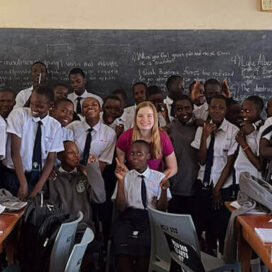Cross purposes
Crucifix by Croatian sculptor and former ND professor installed in Mendoza atrium as a reminder of purpose and faith.
Published: March 22, 2024 / Author: John Nagy (M.A. ’00)
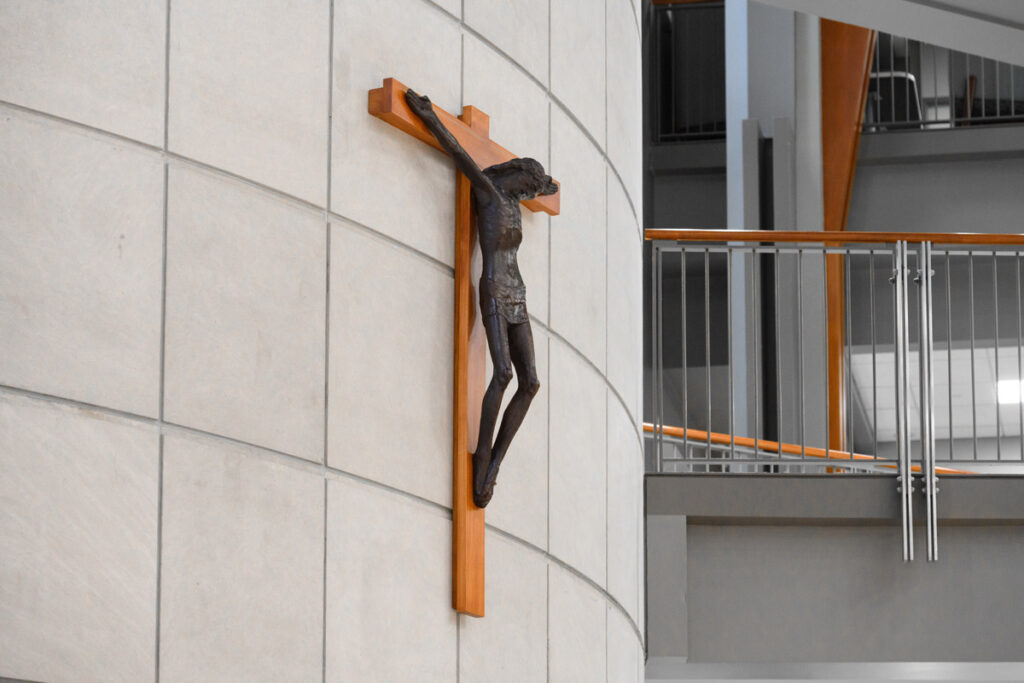
Crucifix installed in Mendoza College of Business in 2023. (Photo by Matt Cashore/University of Notre Dame)
Not all crucifixes are created equal.
You may have noticed this yourself when selecting one for your home or sorting through family heirlooms, while visiting an art museum, stopping to pray in a Catholic church or simply walking around the Notre Dame campus.
But Ron Grisoli, doing his homework as the new facilities program director at Mendoza, was learning this lesson the hard way.
In his first month on the job during the fall semester 2022, Grisoli was summoned to a “walk-and-talk” meeting with the College’s dean, Martijn Cremers. Joined by senior director of operations Rob Kelly (MBA ’03, ND ’03) and Grisoli’s then-boss, Director of Facilities & Program Operations Morgan McCoy, the delegation walked from one campus building to the next, the dean pointing out notable features similar to an undergraduate tour guide.
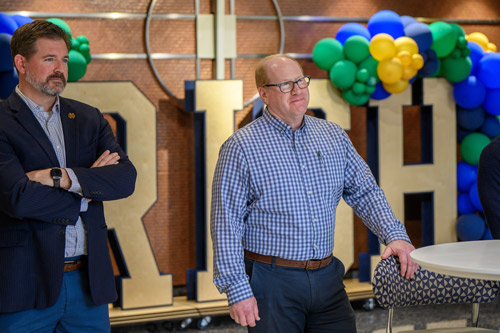
Rob Kelly (left) and Ron Grisoli (right) at the crucifix blessing.
The talk was all architectural features, flooring, railings, trims, “things like that,” Grisoli recalled, with Cremers expressing his tastes and preferences for a planned three-story addition and the ongoing work of renovating the College’s somewhat chilly, modern, institutional and uber-professional existing indoor aesthetic.
Then they returned to Mendoza and stood in its central atrium, for decades a brisk pass-through of glass, steel, cast concrete and terrazzo flooring if ever there was one. Under Cremers’ direction and the labors of Grisoli’s predecessor, the space had already warmed up considerably: big farm tables for group study and tall, bistro-style café seating for one-on-one conversation. Soft chairs and coffee tables added a casual air. And the place had filled up like the living room of an enormous household. But one thing was yet missing.
Yep. A crucifix. Grisoli paraphrased the dean as he explained: “What belongs in any good Catholic home is, Christ has to be there at the center. So, this is the center of the College.” The space needed a crucifix “to remind us of our purpose and our Catholic faith.”
This, insofar as it goes, was not controversial. The University of Notre Dame prides itself on having a crucifix in every classroom and building. But public spaces often remain unclaimed territory for this kind of religious iconography. The question was, what sort of crucifix would suit it?
If Grisoli thought the answer might come to him in an afternoon, he was mistaken.
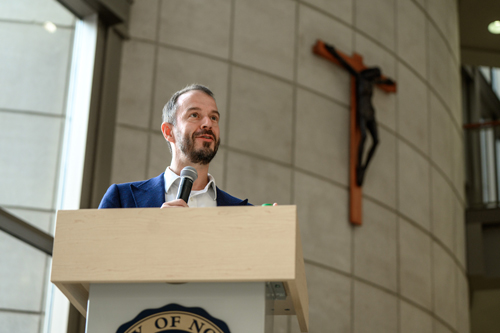
Dean Cremers speaking at the blessing ceremony for the crucifix. (Photo by Matt Cashore/University of Notre Dame)
Parish closings in recent decades have created a significant national surplus of religious artifacts: crucifixes, Stations of the Cross, statuary and icons. Grisoli scoured the internet, “but nothing seemed to fit the space,” he said.
“It was a lot of old plaster, a lot of graphic — very graphic — corpuses and crucifixes, which didn’t really match. I looked for brand-new, off-the-shelf things,” he said, “and nothing really jibed.”
This went on for about a month. Granted, it’s not like he dropped everything else. The College has a lot going on and Grisoli is a busy guy. One day, something prompted him to refocus his search closer to home, “and that’s how I came across our Campus Crucifix Initiative,” he said. “Who knew that we had a whole committee and initiative that curates and acquires crucifixes for classrooms on campus?”
The Campus Crucifix Initiative “was started by Mark Roche, the former dean of the College of Arts and Letters, to try and show the international nature of Catholicism and Notre Dame,” explained Father Austin Collins, C.S.C., the University’s vice president for mission engagement and Church affairs who also happens to be an art professor, an accomplished sculptor whose work may be seen, for instance, in public installations in downtown South Bend and, happily — especially for Grisoli — is a member of this crucifix committee. Its mission is to seek out significant artistic expressions of the passion and death of Jesus Christ from artists and artisans all over the world and to locate them around campus in classrooms and auditoriums both as opportunities for cultural enrichment and as more arresting invitations to prayer and reflection than mass-produced crucifixes typically provide.
“I think it calls the viewer into more attention,” Collins said.
In this case, Father Collins had an answer for Grisoli practically at hand. You might call it a final gift from a prominent international sculptor who lived and worked his last days in a studio at Notre Dame, his door inside the University’s old art gallery roughly a football field’s length from the future site of the Mendoza College of Business, right up until his death 62 years ago.
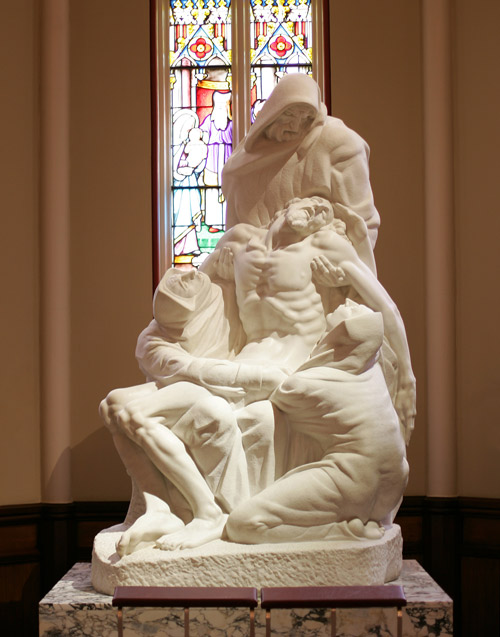
Pieta sculpture in the Basilica of the Sacred Heart. (Photo by Matt Cashore/University of Notre Dame)
The artist’s name was Ivan Meštrović. You know his work. Christ and the Samaritan Woman outside O’Shaughnessy Hall? That’s Meštrović. The gorgeous, heartrending marble Pietà in one of the apsidal chapels to the right of the choir inside the Basilica of the Sacred Heart? Meštrović. Moses outside Hesburgh Library?
That’s actually the work of one of Meštrović’s students, but it reveals the master’s influence.
A walking tour of the multifaceted Croatian sculptor’s legacy at Notre Dame alone would take you the better part of a day. The Eck Visitors Center is a good place to start, as it’s home to five pieces. The new Raclin Murphy Museum of Art has three pieces on display: Be sure to check out the giant plaster cast head of Moses — a favorite subject — inside Ivan’s Cafe and Bookshop on the first floor and the walnut Ashbaugh Madonna by the door.
Who was this man?
He was the son of a Croatian shepherd who became a stonemason’s apprentice at only 16 years of age. By 25, he was living in Paris and enjoying an international reputation. Rodin, for one, famously doffed his beret to Meštrović as his artistic superior. A master of form and a latecomer to Art Nouveau with its natural motifs, fluid dynamism, devotion to mythic subjects and national pride, he would find his preeminence challenged by movements toward abstraction and concept even as he adapted his own work and continued to receive commissions. His advocacy of a pan-Slavic national identity would get him in trouble first with authorities of the Austro-Hungarian Empire, then Croatian nationalists, then Yugoslavian communists.
A refugee from both World Wars, he once served nearly five harrowing months in a Croatian prison before the Vatican negotiated his release. Pope Pius XII received him in Rome; roughly a decade later, President Dwight D. Eisenhower would preside over the naturalization ceremony in which Meštrović became a citizen of the United States.
He taught for a time at Syracuse University. Later, Father Ted Hesburgh, C.S.C., would recall for a Chicago Tribune reporter how he lured the great man away from upstate New York. “I could see he wasn’t too happy,” Hesburgh said in 2008. “So I said, ‘Why don’t you come to Notre Dame? That would be an atmosphere in which you could really work.’”
The artist and his wife, Olga, liked South Bend, and they liked the University because it was Catholic. No acts of vandalism to his work were ever reported here as he had experienced before. And among the many works Meštrović left behind was a crucifix with a simple bronze corpus weighing about 75 pounds and situated on an otherwise plain wooden cross with a conspicuously short upright above the crossbeam. Dated to 1948, this crucifix once appeared above the interior doorways that for decades connected the Arts and Letters building with what would eventually become the Snite Museum of Art.
The artist’s family granted the University permission to make additional castings of this crucifix, provided that Meštrović’s specifications for cross and corpus were followed to the last detail. Over the years, these crucifixes appeared in the chapel of Malloy Hall, which houses the philosophy and theology departments; in the DeBartolo Performing Arts Center; in Jordan Hall of Science; and in Johnson Family Hall, a newer women’s residence. (The O’Shaughnessy Hall crucifix was moved to the Eck Visitors Center, home of the Alumni Association, soon after the center was built.)
Per Father Collins’ advice, Mendoza’s crucifix would further link the College religiously and symbolically not only with the University’s efforts toward global engagement but with its ubiquitous push toward high-level multidisciplinarity as well.
Many of those castings are the work of Miklos P. Simon (MFA ’91), a sculptor and academic who splits his professional time between Chicago’s Columbia College of Art and Design and the secluded art studios of Holy Cross Annex between the campus lakes.
You’d probably recognize a few of the Hungarian American artist’s pieces, too: The renovated bronze fountain at the Grotto is a prominent example; another is the relief of the Flight into Egypt on the north side of the new Corby Hall. As an art student, Simon and his peers at the prestigious Hungarian Academy of Fine Arts in Budapest idolized Meštrović well into the 1980s; he still remembers the thrill of discovering his hero’s monumental 1928 work, Equestrian Indians, in Grant Park while furthering his studies at the Art Institute of Chicago.
He described this Meštrović crucifix as stylistically atypical of the artist’s work, even in his later years, but its elongated form and slender extremities also present a welcome diversion from a certain tendency in crucifix design to make the figure “too muscly.”
“Christ wasn’t a bodybuilder,” he said.
While the surfaces of Meštrović’s later sculptures are often rough, “this one is a little bit smoother,” he noted, adding that the typical over-definition of Christ’s body ignores the loosening that happens to human musculature in death. In Meštrović’s conception, “the body’s gone. The presence is there, but it’s not tense.”

A close-up view of Mendoza’s crucifix (Photo by Matt Cashore/University of Notre Dame)
Producing the sculpture’s sixth iteration took about three months amid other tasks. Simon and a hired assistant poured the bronze inside Riley Hall. Meanwhile, carpenters contracted through the University Architect’s office confronted the challenge of conforming Meštrović’s cross design to the cylindrical central column of the atrium’s broad spiral staircase. Consulting with Father Collins, they created a concave backing for the crossbeam that would appropriately conceal the mounting hardware. The wood they selected, maple, matches the College’s trimwork. Installation with a boom lift took about two and a half hours one afternoon in mid-October.
Several dozen administrators, faculty and students attended the prayerful dedication ceremony that Cremers and Collins hosted on October 26, 2023. The dean was pleased. “The crucifix,” he wrote in announcing its installation, “is a symbol of God’s sacrifice, love and mercy … I hope it is a daily encouragement to all of us in the important work of serving our students and each other.”
Grisoli was happy, too. “It looks like it’s always been there,” he said just days after the 13-month task, a small, meaningful project far afield from the routine of his day-to-day responsibilities, was completed. “It’s very nice to have this cross from an artist who’s within the Notre Dame family.”

